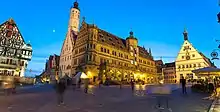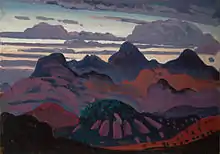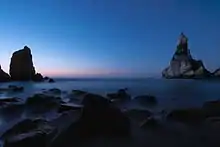Blue hour
The blue hour (from French l'heure bleue;[1][lower-alpha 1] pronounced [lœʁ blø]) is the period of twilight (in the morning or evening, around the nautical stage) when the Sun is at a significant depth below the horizon and residual, indirect sunlight takes on a predominantly blue shade, which differs from the one visible during most of a clear day, which is caused by Rayleigh scattering.
.jpg.webp)





The blue hour occurs when the Sun is far enough below the horizon so that the sunlight's blue wavelengths dominate due to the Chappuis absorption caused by ozone.[2] Since the term is colloquial, it lacks an official definition similar to dawn, dusk, and the three stages of twilight. Rather, it refers to a state of natural lighting that usually occurs around the nautical stage of the twilight period (at dawn or dusk).[3]
How and when it happens
The still commonly presented incorrect explanation claims that the Earth's post-sunset and pre-sunrise atmosphere solely receives and disperses the sun's shorter blue wavelengths and scatters the longer, reddish wavelengths to explain why the hue of this hour is so blue.[4] In fact, the blue hour occurs when the Sun is far enough below the horizon so that the sunlight's blue wavelengths dominate due to the Chappuis absorption caused by ozone.[2] Even some websites dedicated to information about ozone still propagate the incorrect claim that ozone does not contribute to the blue color of the sky,[5] though this effect is much weaker during the rest of the day, between morning and evening twilight.
When the sky is clear, the blue hour can be a colorful spectacle, with the indirect sunlight tinting the sky yellow, orange, red, and blue. This effect is caused by the relative diffusibility of shorter wavelengths (bluer rays) of visible light versus the longer wavelengths (redder rays).[6] During the blue "hour", red light passes through space while blue light is scattered in the atmosphere, and thus reaches Earth's surface. Blue hour usually lasts about 20–30 minutes right after sunset and right before sunrise. For instance, if the sun sets at 6:30 p.m., blue hour would occur from 6:40 p.m. to 7 p.m.. If the sun were to rise at 7:30 a.m., blue hour would occur from 7 a.m. to 7:20 a.m.. Time of year, location, and air quality all have an impact on the exact timing of blue hour.[7]
Blue hour photography
Many artists value this period for the quality of the soft light. Although the blue hour does not have an official definition, the blue color spectrum is most prominent when the Sun is between 4° and 8° below the horizon.[6] Photographers cherish blue hour for the tranquil mood it sets. When photographing blue hour it is recommended to capture subjects that have artificial light sources, such as buildings, monuments, cityscapes, or bridges.
Blue hour in art
- See also: Commons: Paintings of twilights
_l'_Heure_bleue%252C1890%252Chuile_sur_toile_191%252C5_x_176_cm%252C_Mus%C3%A9e_des_Beaux-Arts_de_Leipzig.jpg.webp) Die blaue Stunde (1890), painting by Max Klinger
Die blaue Stunde (1890), painting by Max Klinger_-_Ant%C3%B3nio_C%C3%A2ndido_da_Cunha.png.webp) Sunset (1897), painting by António Cândido da Cunha
Sunset (1897), painting by António Cândido da Cunha Twilight (1897), painting by Ödön Tull
Twilight (1897), painting by Ödön Tull Deep Twilight, Pyrenees (1912/1913), painting by James Dickson Innes
Deep Twilight, Pyrenees (1912/1913), painting by James Dickson Innes_%253B_Charles_W._Bartlett._LCCN2018646015.jpg.webp) Taj-Mahal, twilight (1920), woodcut by Charles W. Bartlett
Taj-Mahal, twilight (1920), woodcut by Charles W. Bartlett Evening at the Lumber Yards of Kiba (1920), woodcut by Kawase Hasui
Evening at the Lumber Yards of Kiba (1920), woodcut by Kawase Hasui
See also
Notes
- A similar calque is used in many languages.
References
- Verfaillie, Roland (2011). L'heure Bleue. San Francisco: Purple Onion Press. p. 5.
- Hoeppe, Götz (2007). Why the Sky Is Blue: Discovering the Color of Life. Princeton: Princeton University Press. pp. 249–53. ISBN 0-691-12453-1.
- "The Blue Hour". timeanddate.com. Retrieved 6 April 2019.
- "What is the blue hour? Learn about this magic time between daylight and darkness". mnn.com. Retrieved 7 April 2019.
- "Blue Hour – Magic Hour". timeanddate.com. Retrieved 16 October 2017.
- "What is the blue hour?". earthsky.org. Retrieved 7 April 2019.
External links
| Wikimedia Commons has media related to Blue hour. |



